Analysis of External and Internal Environment for Vodafone
VerifiedAdded on 2023/01/10
|14
|3910
|32
AI Summary
This report analyzes the external and internal environment of Vodafone, a multinational telecommunications service company. It includes a PESTEL analysis, Porter's 5 forces analysis, value chain analysis, VRIO analysis, and SWOT analysis. The report also evaluates Vodafone's strategy using the TOWS Matrix.
Contribute Materials
Your contribution can guide someone’s learning journey. Share your
documents today.
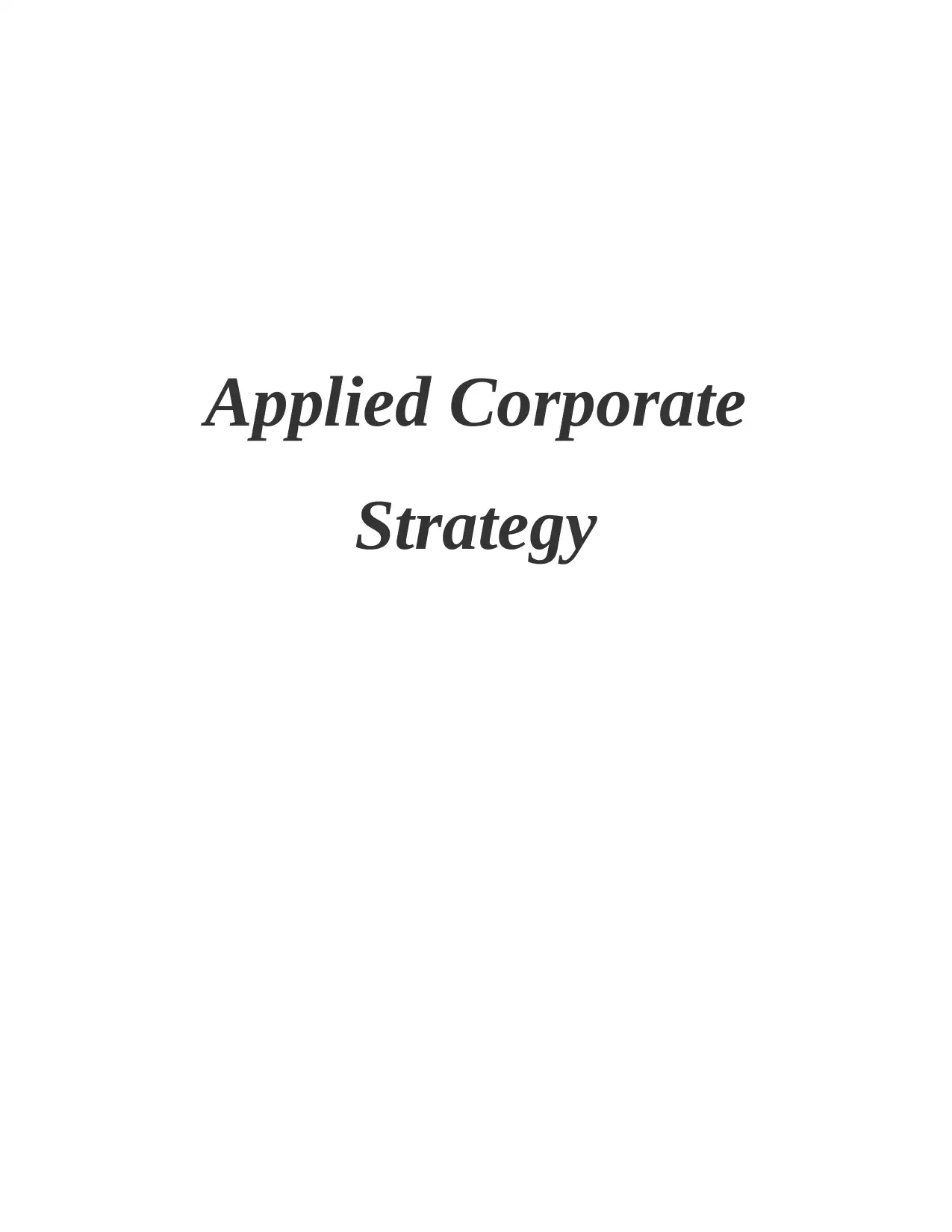
Applied Corporate
Strategy
Strategy
Secure Best Marks with AI Grader
Need help grading? Try our AI Grader for instant feedback on your assignments.
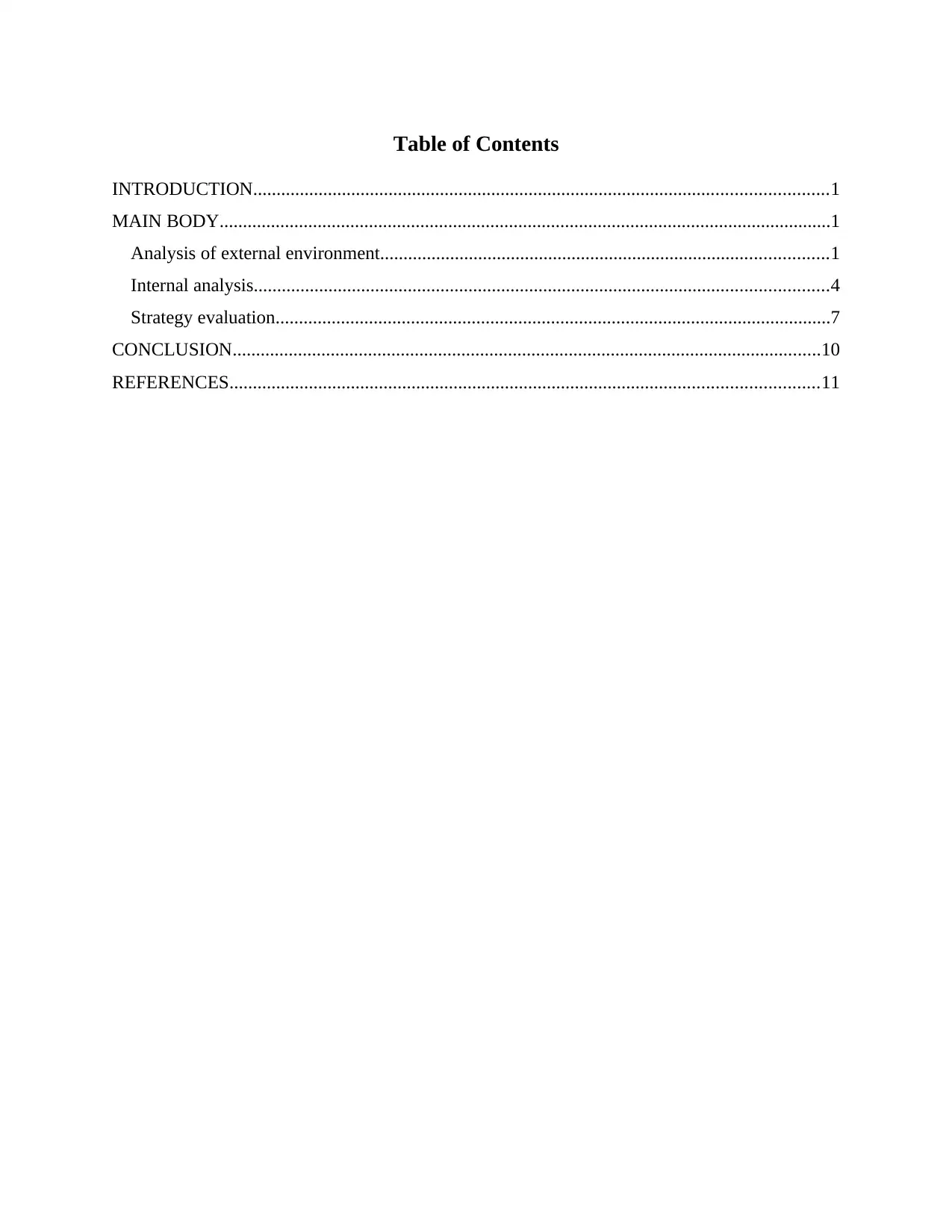
Table of Contents
INTRODUCTION...........................................................................................................................1
MAIN BODY...................................................................................................................................1
Analysis of external environment................................................................................................1
Internal analysis...........................................................................................................................4
Strategy evaluation.......................................................................................................................7
CONCLUSION..............................................................................................................................10
REFERENCES..............................................................................................................................11
INTRODUCTION...........................................................................................................................1
MAIN BODY...................................................................................................................................1
Analysis of external environment................................................................................................1
Internal analysis...........................................................................................................................4
Strategy evaluation.......................................................................................................................7
CONCLUSION..............................................................................................................................10
REFERENCES..............................................................................................................................11
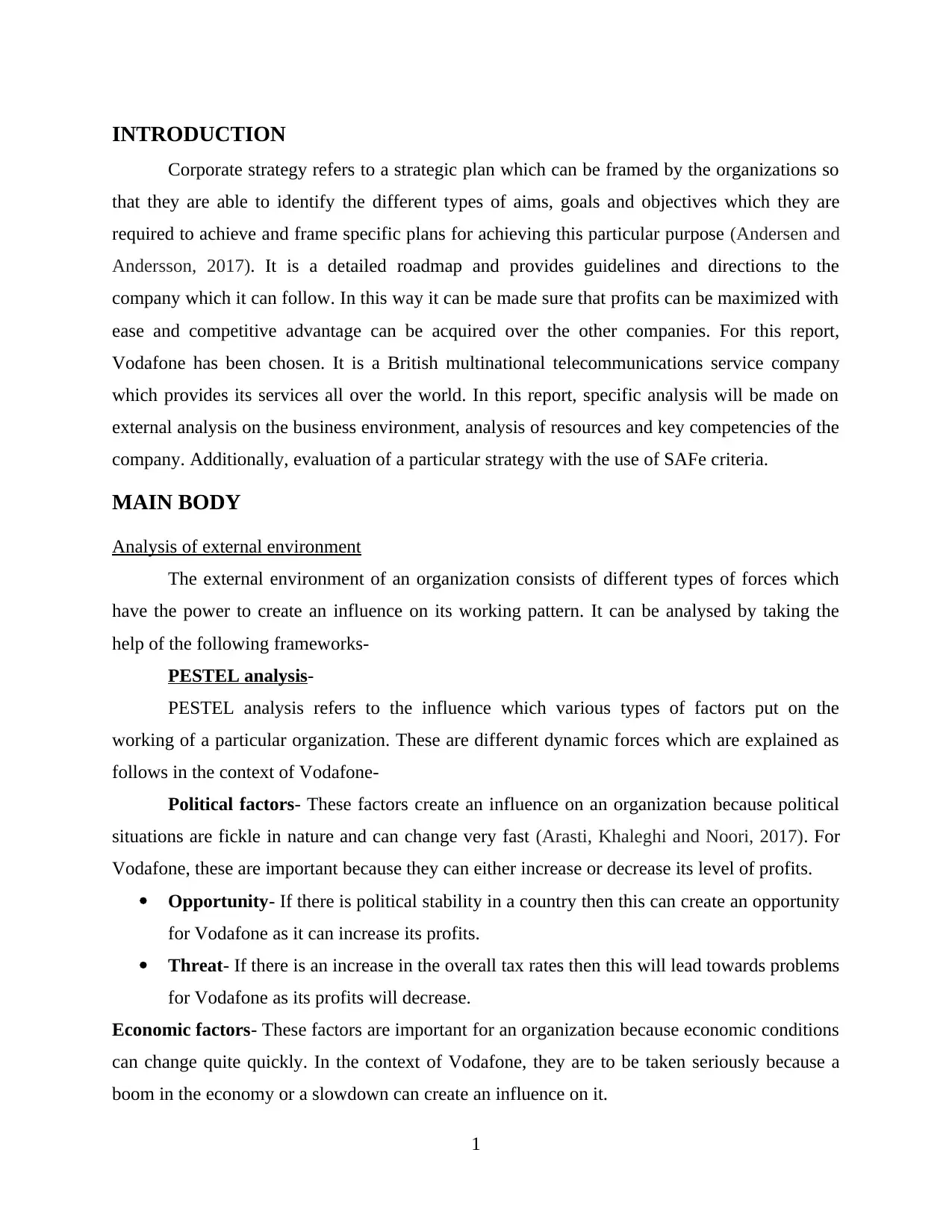
INTRODUCTION
Corporate strategy refers to a strategic plan which can be framed by the organizations so
that they are able to identify the different types of aims, goals and objectives which they are
required to achieve and frame specific plans for achieving this particular purpose (Andersen and
Andersson, 2017). It is a detailed roadmap and provides guidelines and directions to the
company which it can follow. In this way it can be made sure that profits can be maximized with
ease and competitive advantage can be acquired over the other companies. For this report,
Vodafone has been chosen. It is a British multinational telecommunications service company
which provides its services all over the world. In this report, specific analysis will be made on
external analysis on the business environment, analysis of resources and key competencies of the
company. Additionally, evaluation of a particular strategy with the use of SAFe criteria.
MAIN BODY
Analysis of external environment
The external environment of an organization consists of different types of forces which
have the power to create an influence on its working pattern. It can be analysed by taking the
help of the following frameworks-
PESTEL analysis-
PESTEL analysis refers to the influence which various types of factors put on the
working of a particular organization. These are different dynamic forces which are explained as
follows in the context of Vodafone-
Political factors- These factors create an influence on an organization because political
situations are fickle in nature and can change very fast (Arasti, Khaleghi and Noori, 2017). For
Vodafone, these are important because they can either increase or decrease its level of profits.
Opportunity- If there is political stability in a country then this can create an opportunity
for Vodafone as it can increase its profits.
Threat- If there is an increase in the overall tax rates then this will lead towards problems
for Vodafone as its profits will decrease.
Economic factors- These factors are important for an organization because economic conditions
can change quite quickly. In the context of Vodafone, they are to be taken seriously because a
boom in the economy or a slowdown can create an influence on it.
1
Corporate strategy refers to a strategic plan which can be framed by the organizations so
that they are able to identify the different types of aims, goals and objectives which they are
required to achieve and frame specific plans for achieving this particular purpose (Andersen and
Andersson, 2017). It is a detailed roadmap and provides guidelines and directions to the
company which it can follow. In this way it can be made sure that profits can be maximized with
ease and competitive advantage can be acquired over the other companies. For this report,
Vodafone has been chosen. It is a British multinational telecommunications service company
which provides its services all over the world. In this report, specific analysis will be made on
external analysis on the business environment, analysis of resources and key competencies of the
company. Additionally, evaluation of a particular strategy with the use of SAFe criteria.
MAIN BODY
Analysis of external environment
The external environment of an organization consists of different types of forces which
have the power to create an influence on its working pattern. It can be analysed by taking the
help of the following frameworks-
PESTEL analysis-
PESTEL analysis refers to the influence which various types of factors put on the
working of a particular organization. These are different dynamic forces which are explained as
follows in the context of Vodafone-
Political factors- These factors create an influence on an organization because political
situations are fickle in nature and can change very fast (Arasti, Khaleghi and Noori, 2017). For
Vodafone, these are important because they can either increase or decrease its level of profits.
Opportunity- If there is political stability in a country then this can create an opportunity
for Vodafone as it can increase its profits.
Threat- If there is an increase in the overall tax rates then this will lead towards problems
for Vodafone as its profits will decrease.
Economic factors- These factors are important for an organization because economic conditions
can change quite quickly. In the context of Vodafone, they are to be taken seriously because a
boom in the economy or a slowdown can create an influence on it.
1
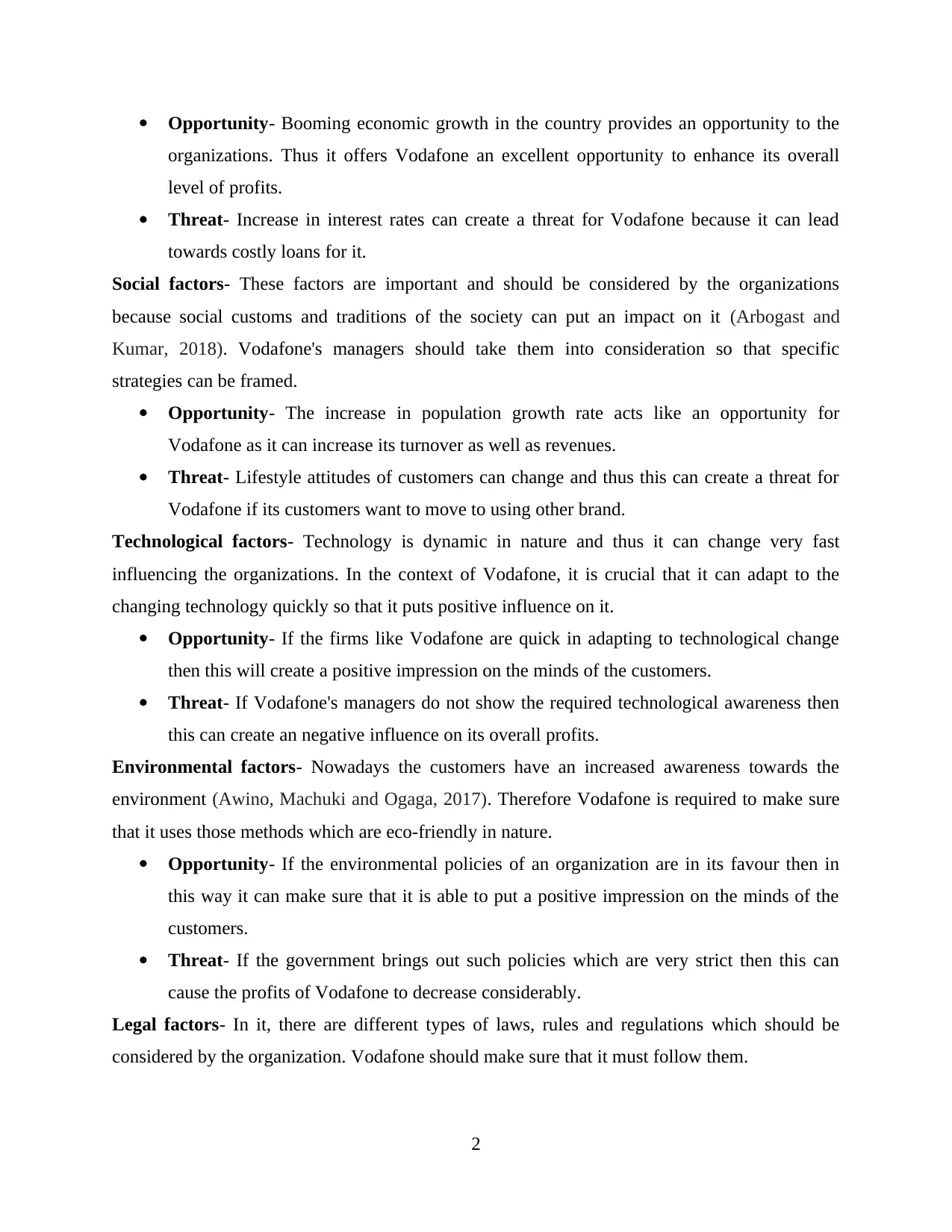
Opportunity- Booming economic growth in the country provides an opportunity to the
organizations. Thus it offers Vodafone an excellent opportunity to enhance its overall
level of profits.
Threat- Increase in interest rates can create a threat for Vodafone because it can lead
towards costly loans for it.
Social factors- These factors are important and should be considered by the organizations
because social customs and traditions of the society can put an impact on it (Arbogast and
Kumar, 2018). Vodafone's managers should take them into consideration so that specific
strategies can be framed.
Opportunity- The increase in population growth rate acts like an opportunity for
Vodafone as it can increase its turnover as well as revenues.
Threat- Lifestyle attitudes of customers can change and thus this can create a threat for
Vodafone if its customers want to move to using other brand.
Technological factors- Technology is dynamic in nature and thus it can change very fast
influencing the organizations. In the context of Vodafone, it is crucial that it can adapt to the
changing technology quickly so that it puts positive influence on it.
Opportunity- If the firms like Vodafone are quick in adapting to technological change
then this will create a positive impression on the minds of the customers.
Threat- If Vodafone's managers do not show the required technological awareness then
this can create an negative influence on its overall profits.
Environmental factors- Nowadays the customers have an increased awareness towards the
environment (Awino, Machuki and Ogaga, 2017). Therefore Vodafone is required to make sure
that it uses those methods which are eco-friendly in nature.
Opportunity- If the environmental policies of an organization are in its favour then in
this way it can make sure that it is able to put a positive impression on the minds of the
customers.
Threat- If the government brings out such policies which are very strict then this can
cause the profits of Vodafone to decrease considerably.
Legal factors- In it, there are different types of laws, rules and regulations which should be
considered by the organization. Vodafone should make sure that it must follow them.
2
organizations. Thus it offers Vodafone an excellent opportunity to enhance its overall
level of profits.
Threat- Increase in interest rates can create a threat for Vodafone because it can lead
towards costly loans for it.
Social factors- These factors are important and should be considered by the organizations
because social customs and traditions of the society can put an impact on it (Arbogast and
Kumar, 2018). Vodafone's managers should take them into consideration so that specific
strategies can be framed.
Opportunity- The increase in population growth rate acts like an opportunity for
Vodafone as it can increase its turnover as well as revenues.
Threat- Lifestyle attitudes of customers can change and thus this can create a threat for
Vodafone if its customers want to move to using other brand.
Technological factors- Technology is dynamic in nature and thus it can change very fast
influencing the organizations. In the context of Vodafone, it is crucial that it can adapt to the
changing technology quickly so that it puts positive influence on it.
Opportunity- If the firms like Vodafone are quick in adapting to technological change
then this will create a positive impression on the minds of the customers.
Threat- If Vodafone's managers do not show the required technological awareness then
this can create an negative influence on its overall profits.
Environmental factors- Nowadays the customers have an increased awareness towards the
environment (Awino, Machuki and Ogaga, 2017). Therefore Vodafone is required to make sure
that it uses those methods which are eco-friendly in nature.
Opportunity- If the environmental policies of an organization are in its favour then in
this way it can make sure that it is able to put a positive impression on the minds of the
customers.
Threat- If the government brings out such policies which are very strict then this can
cause the profits of Vodafone to decrease considerably.
Legal factors- In it, there are different types of laws, rules and regulations which should be
considered by the organization. Vodafone should make sure that it must follow them.
2
Secure Best Marks with AI Grader
Need help grading? Try our AI Grader for instant feedback on your assignments.
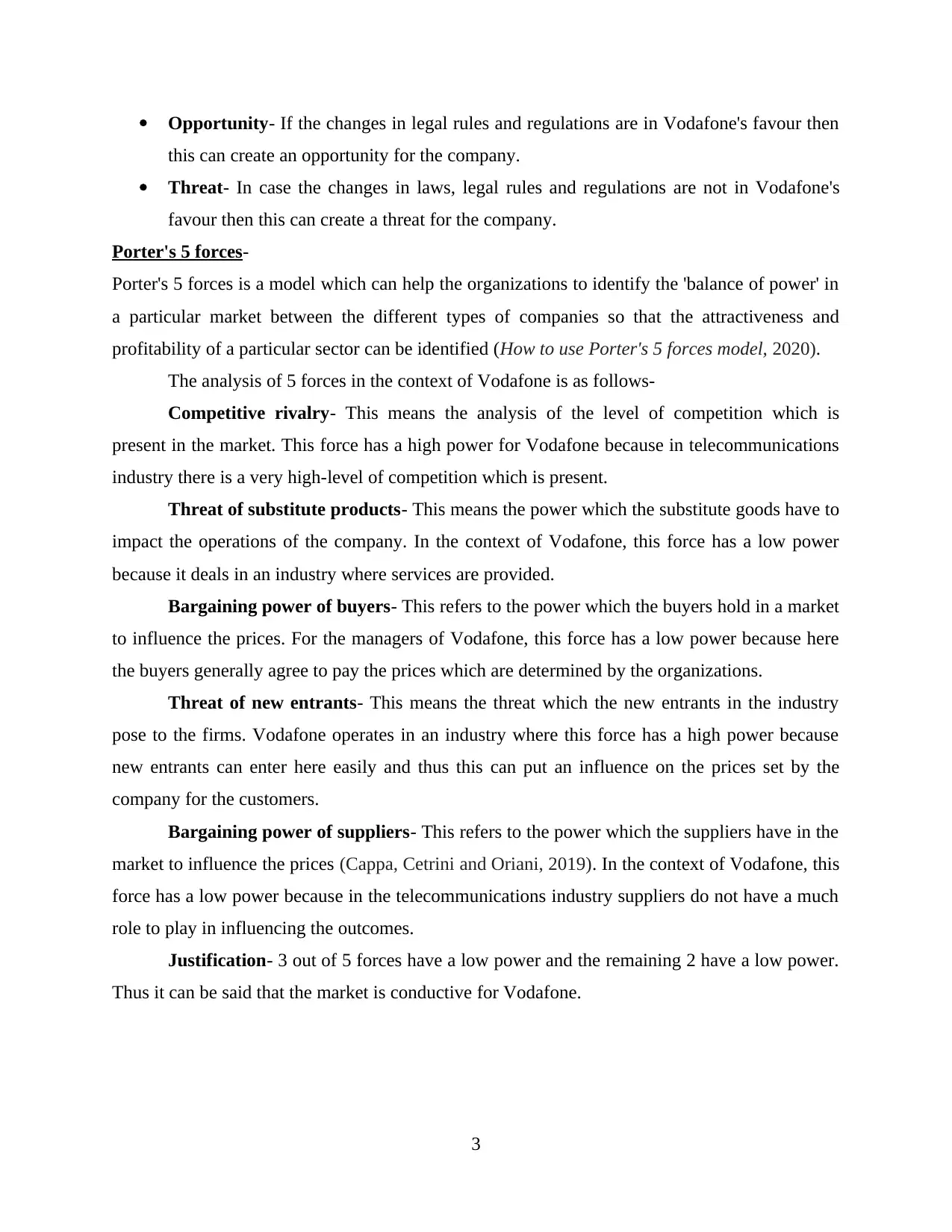
Opportunity- If the changes in legal rules and regulations are in Vodafone's favour then
this can create an opportunity for the company.
Threat- In case the changes in laws, legal rules and regulations are not in Vodafone's
favour then this can create a threat for the company.
Porter's 5 forces-
Porter's 5 forces is a model which can help the organizations to identify the 'balance of power' in
a particular market between the different types of companies so that the attractiveness and
profitability of a particular sector can be identified (How to use Porter's 5 forces model, 2020).
The analysis of 5 forces in the context of Vodafone is as follows-
Competitive rivalry- This means the analysis of the level of competition which is
present in the market. This force has a high power for Vodafone because in telecommunications
industry there is a very high-level of competition which is present.
Threat of substitute products- This means the power which the substitute goods have to
impact the operations of the company. In the context of Vodafone, this force has a low power
because it deals in an industry where services are provided.
Bargaining power of buyers- This refers to the power which the buyers hold in a market
to influence the prices. For the managers of Vodafone, this force has a low power because here
the buyers generally agree to pay the prices which are determined by the organizations.
Threat of new entrants- This means the threat which the new entrants in the industry
pose to the firms. Vodafone operates in an industry where this force has a high power because
new entrants can enter here easily and thus this can put an influence on the prices set by the
company for the customers.
Bargaining power of suppliers- This refers to the power which the suppliers have in the
market to influence the prices (Cappa, Cetrini and Oriani, 2019). In the context of Vodafone, this
force has a low power because in the telecommunications industry suppliers do not have a much
role to play in influencing the outcomes.
Justification- 3 out of 5 forces have a low power and the remaining 2 have a low power.
Thus it can be said that the market is conductive for Vodafone.
3
this can create an opportunity for the company.
Threat- In case the changes in laws, legal rules and regulations are not in Vodafone's
favour then this can create a threat for the company.
Porter's 5 forces-
Porter's 5 forces is a model which can help the organizations to identify the 'balance of power' in
a particular market between the different types of companies so that the attractiveness and
profitability of a particular sector can be identified (How to use Porter's 5 forces model, 2020).
The analysis of 5 forces in the context of Vodafone is as follows-
Competitive rivalry- This means the analysis of the level of competition which is
present in the market. This force has a high power for Vodafone because in telecommunications
industry there is a very high-level of competition which is present.
Threat of substitute products- This means the power which the substitute goods have to
impact the operations of the company. In the context of Vodafone, this force has a low power
because it deals in an industry where services are provided.
Bargaining power of buyers- This refers to the power which the buyers hold in a market
to influence the prices. For the managers of Vodafone, this force has a low power because here
the buyers generally agree to pay the prices which are determined by the organizations.
Threat of new entrants- This means the threat which the new entrants in the industry
pose to the firms. Vodafone operates in an industry where this force has a high power because
new entrants can enter here easily and thus this can put an influence on the prices set by the
company for the customers.
Bargaining power of suppliers- This refers to the power which the suppliers have in the
market to influence the prices (Cappa, Cetrini and Oriani, 2019). In the context of Vodafone, this
force has a low power because in the telecommunications industry suppliers do not have a much
role to play in influencing the outcomes.
Justification- 3 out of 5 forces have a low power and the remaining 2 have a low power.
Thus it can be said that the market is conductive for Vodafone.
3
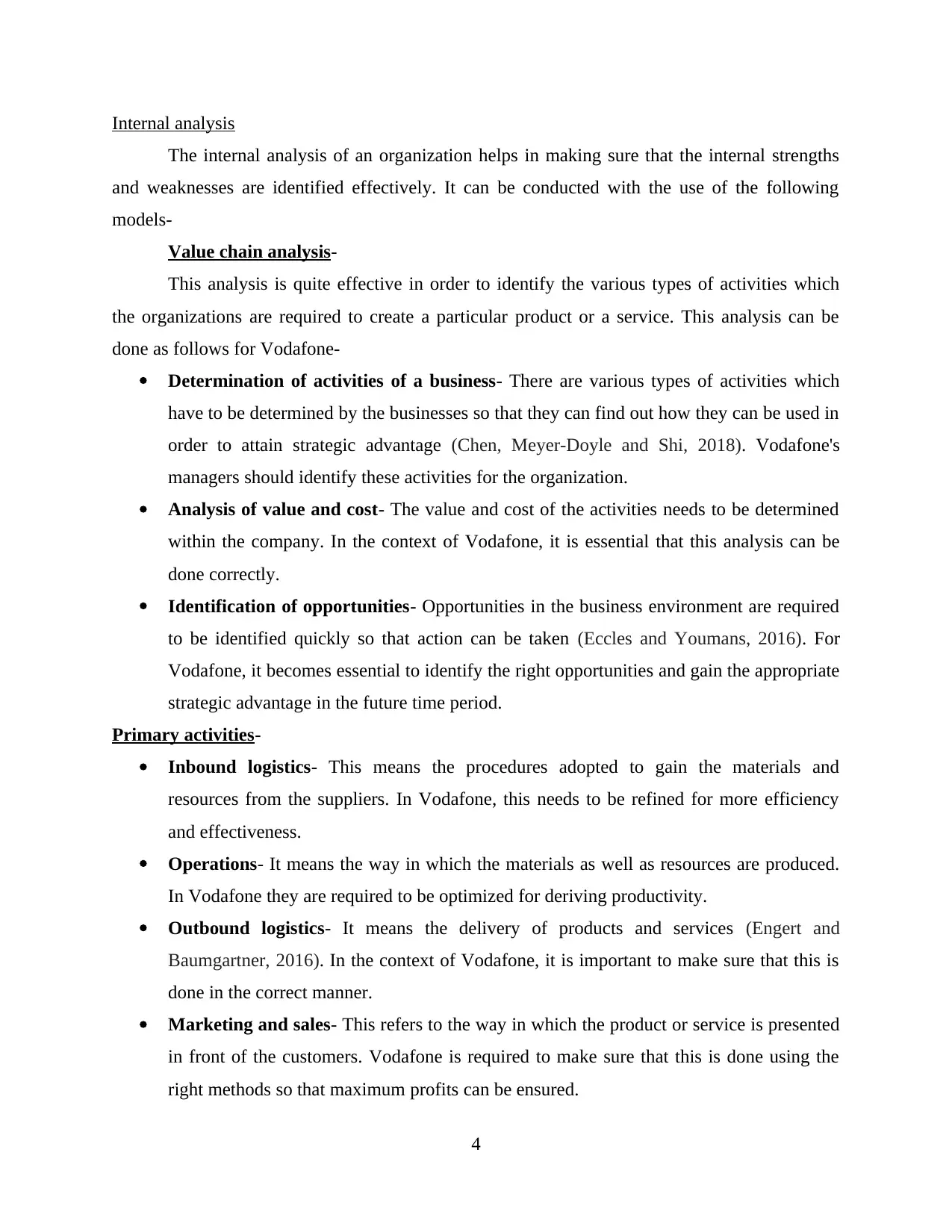
Internal analysis
The internal analysis of an organization helps in making sure that the internal strengths
and weaknesses are identified effectively. It can be conducted with the use of the following
models-
Value chain analysis-
This analysis is quite effective in order to identify the various types of activities which
the organizations are required to create a particular product or a service. This analysis can be
done as follows for Vodafone-
Determination of activities of a business- There are various types of activities which
have to be determined by the businesses so that they can find out how they can be used in
order to attain strategic advantage (Chen, Meyer-Doyle and Shi, 2018). Vodafone's
managers should identify these activities for the organization.
Analysis of value and cost- The value and cost of the activities needs to be determined
within the company. In the context of Vodafone, it is essential that this analysis can be
done correctly.
Identification of opportunities- Opportunities in the business environment are required
to be identified quickly so that action can be taken (Eccles and Youmans, 2016). For
Vodafone, it becomes essential to identify the right opportunities and gain the appropriate
strategic advantage in the future time period.
Primary activities-
Inbound logistics- This means the procedures adopted to gain the materials and
resources from the suppliers. In Vodafone, this needs to be refined for more efficiency
and effectiveness.
Operations- It means the way in which the materials as well as resources are produced.
In Vodafone they are required to be optimized for deriving productivity.
Outbound logistics- It means the delivery of products and services (Engert and
Baumgartner, 2016). In the context of Vodafone, it is important to make sure that this is
done in the correct manner.
Marketing and sales- This refers to the way in which the product or service is presented
in front of the customers. Vodafone is required to make sure that this is done using the
right methods so that maximum profits can be ensured.
4
The internal analysis of an organization helps in making sure that the internal strengths
and weaknesses are identified effectively. It can be conducted with the use of the following
models-
Value chain analysis-
This analysis is quite effective in order to identify the various types of activities which
the organizations are required to create a particular product or a service. This analysis can be
done as follows for Vodafone-
Determination of activities of a business- There are various types of activities which
have to be determined by the businesses so that they can find out how they can be used in
order to attain strategic advantage (Chen, Meyer-Doyle and Shi, 2018). Vodafone's
managers should identify these activities for the organization.
Analysis of value and cost- The value and cost of the activities needs to be determined
within the company. In the context of Vodafone, it is essential that this analysis can be
done correctly.
Identification of opportunities- Opportunities in the business environment are required
to be identified quickly so that action can be taken (Eccles and Youmans, 2016). For
Vodafone, it becomes essential to identify the right opportunities and gain the appropriate
strategic advantage in the future time period.
Primary activities-
Inbound logistics- This means the procedures adopted to gain the materials and
resources from the suppliers. In Vodafone, this needs to be refined for more efficiency
and effectiveness.
Operations- It means the way in which the materials as well as resources are produced.
In Vodafone they are required to be optimized for deriving productivity.
Outbound logistics- It means the delivery of products and services (Engert and
Baumgartner, 2016). In the context of Vodafone, it is important to make sure that this is
done in the correct manner.
Marketing and sales- This refers to the way in which the product or service is presented
in front of the customers. Vodafone is required to make sure that this is done using the
right methods so that maximum profits can be ensured.
4

Services- It refers to the support which is provided by a business to its customers. As
Vodafone operates in an industry where services matter a lot therefore it is required that it
should provide efficient services to its customers and clients.
Support activities-
Firm infrastructure- This means the overall infrastructure in a particular organization
(Foucault and Frésard, 2019). This needs to be improved in Vodafone if it wants to attain
a strategic edge over its various competitors.
HRM- In it, there are various types of processes and systems which are used within a
company for the purpose of management of human resources. In the context of
Vodafone, it is necessary that the right approach is adopted so that the productivity of
employees increases.
Technology development- The technology in a company needs to be developed so that
the required level of efficiency and effectiveness can be achieved. For Vodafone, it is
crucial that it is able to use technology in the correct manner.
Procurement- This refers to the steps adopted for the purpose of procurement of the
resources. In the context of Vodafone, this needs to be done for getting the best resources.
VRIO analysis-
This analysis is used in order to identify the resources and their usefulness for a particular
organization (Millstein, Odoner and Sharma, 2018). In the context of Vodafone, this analysis can
be done as follows-
Resources Valuable Rare Inimitable Organized
Goodwill
Customer
support
Services
Financial
resources
5
Vodafone operates in an industry where services matter a lot therefore it is required that it
should provide efficient services to its customers and clients.
Support activities-
Firm infrastructure- This means the overall infrastructure in a particular organization
(Foucault and Frésard, 2019). This needs to be improved in Vodafone if it wants to attain
a strategic edge over its various competitors.
HRM- In it, there are various types of processes and systems which are used within a
company for the purpose of management of human resources. In the context of
Vodafone, it is necessary that the right approach is adopted so that the productivity of
employees increases.
Technology development- The technology in a company needs to be developed so that
the required level of efficiency and effectiveness can be achieved. For Vodafone, it is
crucial that it is able to use technology in the correct manner.
Procurement- This refers to the steps adopted for the purpose of procurement of the
resources. In the context of Vodafone, this needs to be done for getting the best resources.
VRIO analysis-
This analysis is used in order to identify the resources and their usefulness for a particular
organization (Millstein, Odoner and Sharma, 2018). In the context of Vodafone, this analysis can
be done as follows-
Resources Valuable Rare Inimitable Organized
Goodwill
Customer
support
Services
Financial
resources
5
Paraphrase This Document
Need a fresh take? Get an instant paraphrase of this document with our AI Paraphraser
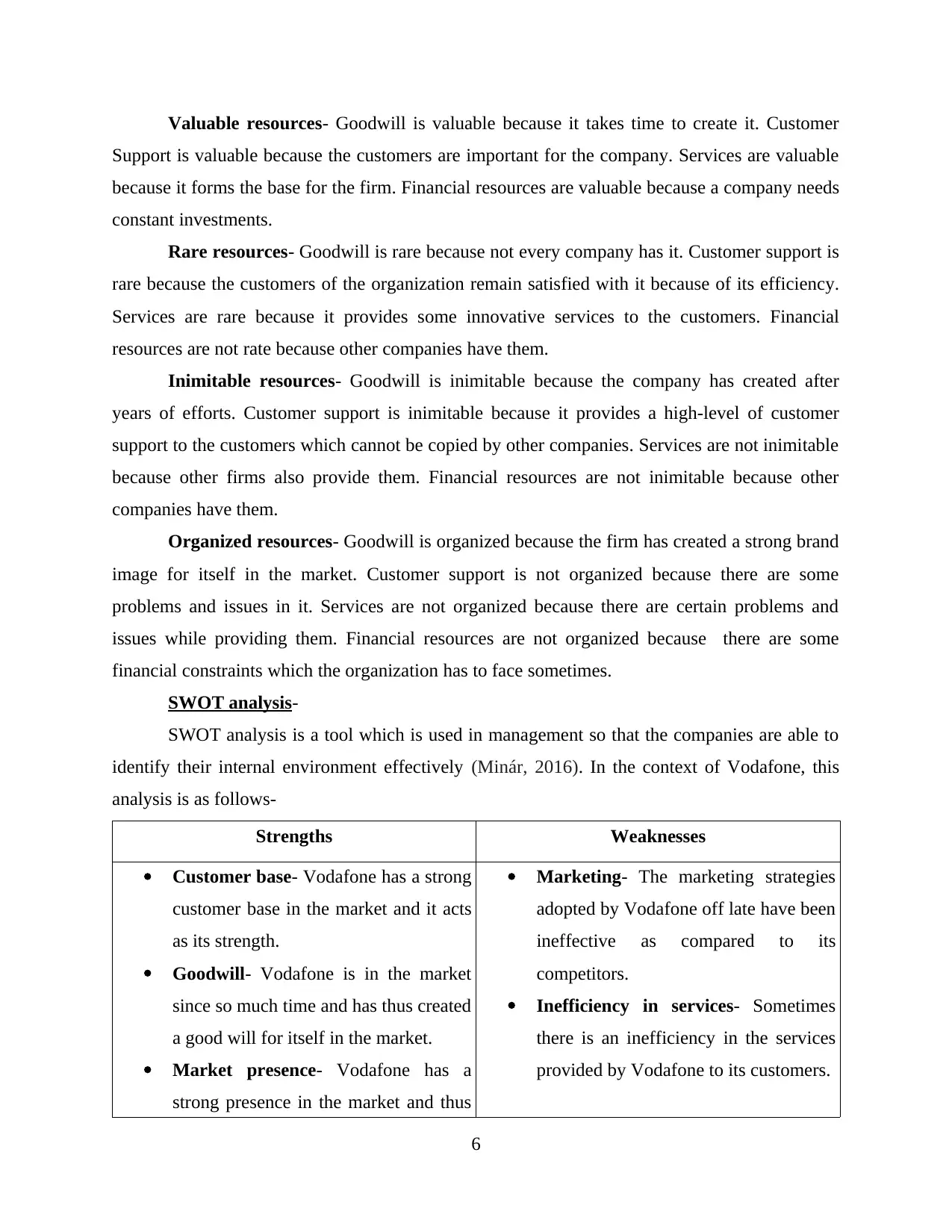
Valuable resources- Goodwill is valuable because it takes time to create it. Customer
Support is valuable because the customers are important for the company. Services are valuable
because it forms the base for the firm. Financial resources are valuable because a company needs
constant investments.
Rare resources- Goodwill is rare because not every company has it. Customer support is
rare because the customers of the organization remain satisfied with it because of its efficiency.
Services are rare because it provides some innovative services to the customers. Financial
resources are not rate because other companies have them.
Inimitable resources- Goodwill is inimitable because the company has created after
years of efforts. Customer support is inimitable because it provides a high-level of customer
support to the customers which cannot be copied by other companies. Services are not inimitable
because other firms also provide them. Financial resources are not inimitable because other
companies have them.
Organized resources- Goodwill is organized because the firm has created a strong brand
image for itself in the market. Customer support is not organized because there are some
problems and issues in it. Services are not organized because there are certain problems and
issues while providing them. Financial resources are not organized because there are some
financial constraints which the organization has to face sometimes.
SWOT analysis-
SWOT analysis is a tool which is used in management so that the companies are able to
identify their internal environment effectively (Minár, 2016). In the context of Vodafone, this
analysis is as follows-
Strengths Weaknesses
Customer base- Vodafone has a strong
customer base in the market and it acts
as its strength.
Goodwill- Vodafone is in the market
since so much time and has thus created
a good will for itself in the market.
Market presence- Vodafone has a
strong presence in the market and thus
Marketing- The marketing strategies
adopted by Vodafone off late have been
ineffective as compared to its
competitors.
Inefficiency in services- Sometimes
there is an inefficiency in the services
provided by Vodafone to its customers.
6
Support is valuable because the customers are important for the company. Services are valuable
because it forms the base for the firm. Financial resources are valuable because a company needs
constant investments.
Rare resources- Goodwill is rare because not every company has it. Customer support is
rare because the customers of the organization remain satisfied with it because of its efficiency.
Services are rare because it provides some innovative services to the customers. Financial
resources are not rate because other companies have them.
Inimitable resources- Goodwill is inimitable because the company has created after
years of efforts. Customer support is inimitable because it provides a high-level of customer
support to the customers which cannot be copied by other companies. Services are not inimitable
because other firms also provide them. Financial resources are not inimitable because other
companies have them.
Organized resources- Goodwill is organized because the firm has created a strong brand
image for itself in the market. Customer support is not organized because there are some
problems and issues in it. Services are not organized because there are certain problems and
issues while providing them. Financial resources are not organized because there are some
financial constraints which the organization has to face sometimes.
SWOT analysis-
SWOT analysis is a tool which is used in management so that the companies are able to
identify their internal environment effectively (Minár, 2016). In the context of Vodafone, this
analysis is as follows-
Strengths Weaknesses
Customer base- Vodafone has a strong
customer base in the market and it acts
as its strength.
Goodwill- Vodafone is in the market
since so much time and has thus created
a good will for itself in the market.
Market presence- Vodafone has a
strong presence in the market and thus
Marketing- The marketing strategies
adopted by Vodafone off late have been
ineffective as compared to its
competitors.
Inefficiency in services- Sometimes
there is an inefficiency in the services
provided by Vodafone to its customers.
6
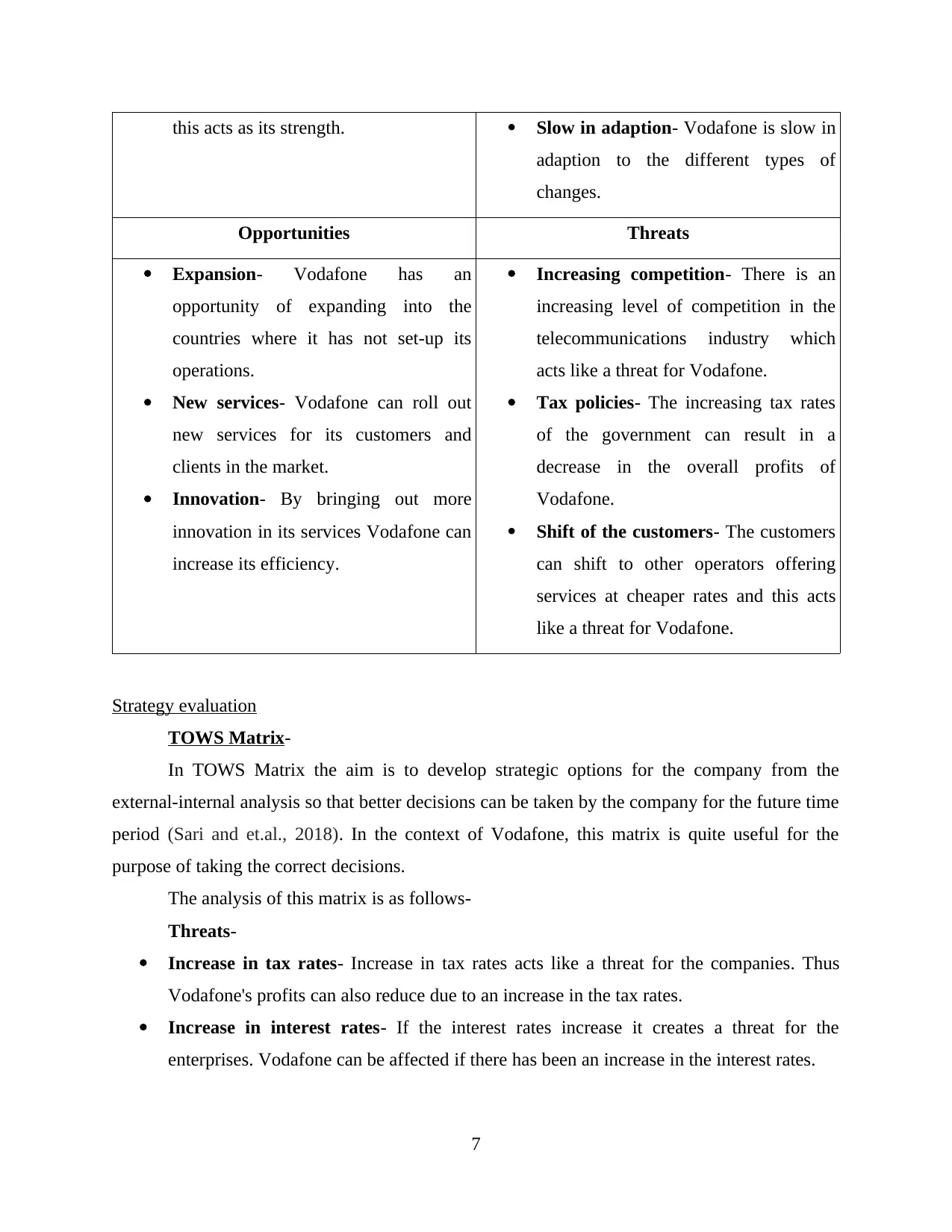
this acts as its strength. Slow in adaption- Vodafone is slow in
adaption to the different types of
changes.
Opportunities Threats
Expansion- Vodafone has an
opportunity of expanding into the
countries where it has not set-up its
operations.
New services- Vodafone can roll out
new services for its customers and
clients in the market.
Innovation- By bringing out more
innovation in its services Vodafone can
increase its efficiency.
Increasing competition- There is an
increasing level of competition in the
telecommunications industry which
acts like a threat for Vodafone.
Tax policies- The increasing tax rates
of the government can result in a
decrease in the overall profits of
Vodafone.
Shift of the customers- The customers
can shift to other operators offering
services at cheaper rates and this acts
like a threat for Vodafone.
Strategy evaluation
TOWS Matrix-
In TOWS Matrix the aim is to develop strategic options for the company from the
external-internal analysis so that better decisions can be taken by the company for the future time
period (Sari and et.al., 2018). In the context of Vodafone, this matrix is quite useful for the
purpose of taking the correct decisions.
The analysis of this matrix is as follows-
Threats-
Increase in tax rates- Increase in tax rates acts like a threat for the companies. Thus
Vodafone's profits can also reduce due to an increase in the tax rates.
Increase in interest rates- If the interest rates increase it creates a threat for the
enterprises. Vodafone can be affected if there has been an increase in the interest rates.
7
adaption to the different types of
changes.
Opportunities Threats
Expansion- Vodafone has an
opportunity of expanding into the
countries where it has not set-up its
operations.
New services- Vodafone can roll out
new services for its customers and
clients in the market.
Innovation- By bringing out more
innovation in its services Vodafone can
increase its efficiency.
Increasing competition- There is an
increasing level of competition in the
telecommunications industry which
acts like a threat for Vodafone.
Tax policies- The increasing tax rates
of the government can result in a
decrease in the overall profits of
Vodafone.
Shift of the customers- The customers
can shift to other operators offering
services at cheaper rates and this acts
like a threat for Vodafone.
Strategy evaluation
TOWS Matrix-
In TOWS Matrix the aim is to develop strategic options for the company from the
external-internal analysis so that better decisions can be taken by the company for the future time
period (Sari and et.al., 2018). In the context of Vodafone, this matrix is quite useful for the
purpose of taking the correct decisions.
The analysis of this matrix is as follows-
Threats-
Increase in tax rates- Increase in tax rates acts like a threat for the companies. Thus
Vodafone's profits can also reduce due to an increase in the tax rates.
Increase in interest rates- If the interest rates increase it creates a threat for the
enterprises. Vodafone can be affected if there has been an increase in the interest rates.
7
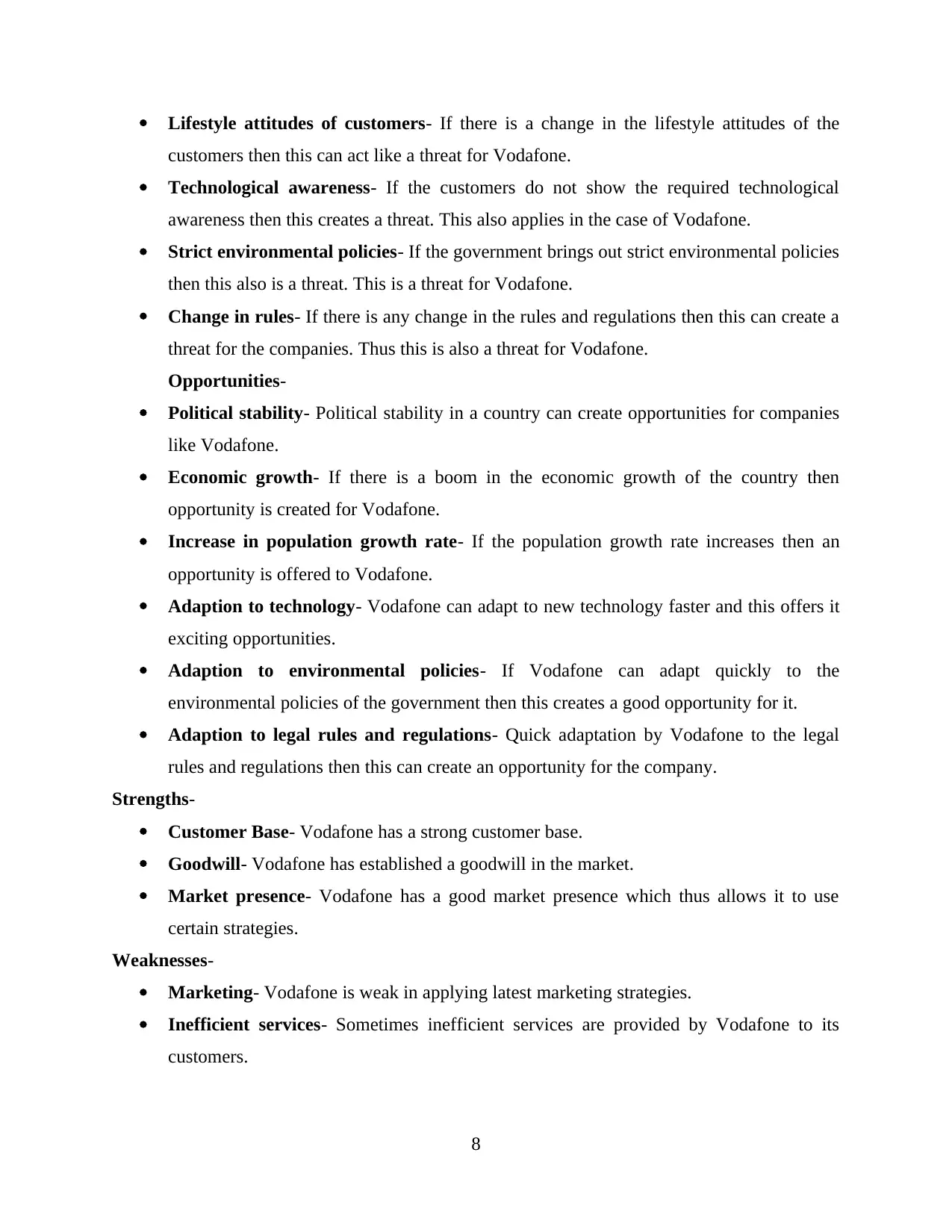
Lifestyle attitudes of customers- If there is a change in the lifestyle attitudes of the
customers then this can act like a threat for Vodafone.
Technological awareness- If the customers do not show the required technological
awareness then this creates a threat. This also applies in the case of Vodafone.
Strict environmental policies- If the government brings out strict environmental policies
then this also is a threat. This is a threat for Vodafone.
Change in rules- If there is any change in the rules and regulations then this can create a
threat for the companies. Thus this is also a threat for Vodafone.
Opportunities-
Political stability- Political stability in a country can create opportunities for companies
like Vodafone.
Economic growth- If there is a boom in the economic growth of the country then
opportunity is created for Vodafone.
Increase in population growth rate- If the population growth rate increases then an
opportunity is offered to Vodafone.
Adaption to technology- Vodafone can adapt to new technology faster and this offers it
exciting opportunities.
Adaption to environmental policies- If Vodafone can adapt quickly to the
environmental policies of the government then this creates a good opportunity for it.
Adaption to legal rules and regulations- Quick adaptation by Vodafone to the legal
rules and regulations then this can create an opportunity for the company.
Strengths-
Customer Base- Vodafone has a strong customer base.
Goodwill- Vodafone has established a goodwill in the market.
Market presence- Vodafone has a good market presence which thus allows it to use
certain strategies.
Weaknesses-
Marketing- Vodafone is weak in applying latest marketing strategies.
Inefficient services- Sometimes inefficient services are provided by Vodafone to its
customers.
8
customers then this can act like a threat for Vodafone.
Technological awareness- If the customers do not show the required technological
awareness then this creates a threat. This also applies in the case of Vodafone.
Strict environmental policies- If the government brings out strict environmental policies
then this also is a threat. This is a threat for Vodafone.
Change in rules- If there is any change in the rules and regulations then this can create a
threat for the companies. Thus this is also a threat for Vodafone.
Opportunities-
Political stability- Political stability in a country can create opportunities for companies
like Vodafone.
Economic growth- If there is a boom in the economic growth of the country then
opportunity is created for Vodafone.
Increase in population growth rate- If the population growth rate increases then an
opportunity is offered to Vodafone.
Adaption to technology- Vodafone can adapt to new technology faster and this offers it
exciting opportunities.
Adaption to environmental policies- If Vodafone can adapt quickly to the
environmental policies of the government then this creates a good opportunity for it.
Adaption to legal rules and regulations- Quick adaptation by Vodafone to the legal
rules and regulations then this can create an opportunity for the company.
Strengths-
Customer Base- Vodafone has a strong customer base.
Goodwill- Vodafone has established a goodwill in the market.
Market presence- Vodafone has a good market presence which thus allows it to use
certain strategies.
Weaknesses-
Marketing- Vodafone is weak in applying latest marketing strategies.
Inefficient services- Sometimes inefficient services are provided by Vodafone to its
customers.
8
Secure Best Marks with AI Grader
Need help grading? Try our AI Grader for instant feedback on your assignments.
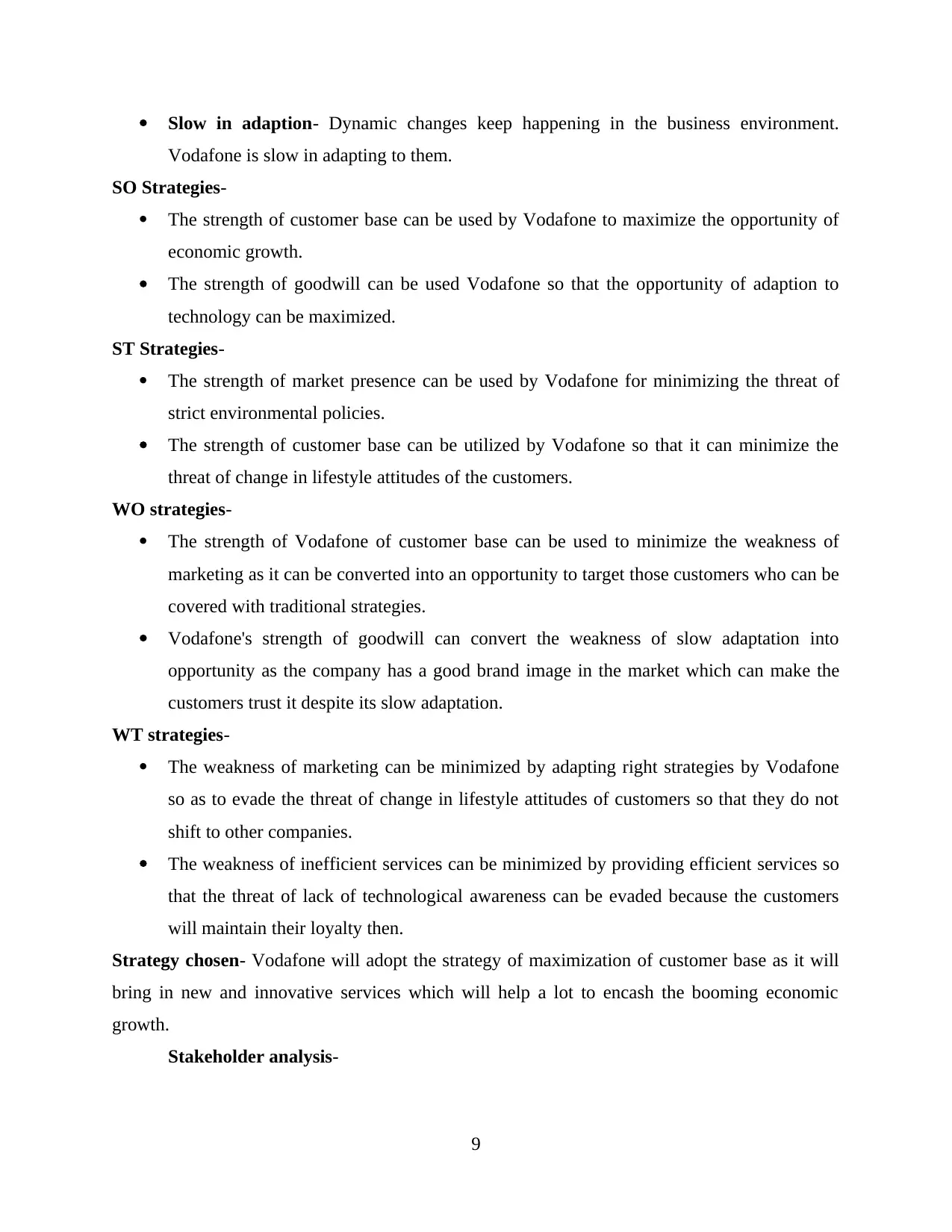
Slow in adaption- Dynamic changes keep happening in the business environment.
Vodafone is slow in adapting to them.
SO Strategies-
The strength of customer base can be used by Vodafone to maximize the opportunity of
economic growth.
The strength of goodwill can be used Vodafone so that the opportunity of adaption to
technology can be maximized.
ST Strategies-
The strength of market presence can be used by Vodafone for minimizing the threat of
strict environmental policies.
The strength of customer base can be utilized by Vodafone so that it can minimize the
threat of change in lifestyle attitudes of the customers.
WO strategies-
The strength of Vodafone of customer base can be used to minimize the weakness of
marketing as it can be converted into an opportunity to target those customers who can be
covered with traditional strategies.
Vodafone's strength of goodwill can convert the weakness of slow adaptation into
opportunity as the company has a good brand image in the market which can make the
customers trust it despite its slow adaptation.
WT strategies-
The weakness of marketing can be minimized by adapting right strategies by Vodafone
so as to evade the threat of change in lifestyle attitudes of customers so that they do not
shift to other companies.
The weakness of inefficient services can be minimized by providing efficient services so
that the threat of lack of technological awareness can be evaded because the customers
will maintain their loyalty then.
Strategy chosen- Vodafone will adopt the strategy of maximization of customer base as it will
bring in new and innovative services which will help a lot to encash the booming economic
growth.
Stakeholder analysis-
9
Vodafone is slow in adapting to them.
SO Strategies-
The strength of customer base can be used by Vodafone to maximize the opportunity of
economic growth.
The strength of goodwill can be used Vodafone so that the opportunity of adaption to
technology can be maximized.
ST Strategies-
The strength of market presence can be used by Vodafone for minimizing the threat of
strict environmental policies.
The strength of customer base can be utilized by Vodafone so that it can minimize the
threat of change in lifestyle attitudes of the customers.
WO strategies-
The strength of Vodafone of customer base can be used to minimize the weakness of
marketing as it can be converted into an opportunity to target those customers who can be
covered with traditional strategies.
Vodafone's strength of goodwill can convert the weakness of slow adaptation into
opportunity as the company has a good brand image in the market which can make the
customers trust it despite its slow adaptation.
WT strategies-
The weakness of marketing can be minimized by adapting right strategies by Vodafone
so as to evade the threat of change in lifestyle attitudes of customers so that they do not
shift to other companies.
The weakness of inefficient services can be minimized by providing efficient services so
that the threat of lack of technological awareness can be evaded because the customers
will maintain their loyalty then.
Strategy chosen- Vodafone will adopt the strategy of maximization of customer base as it will
bring in new and innovative services which will help a lot to encash the booming economic
growth.
Stakeholder analysis-
9
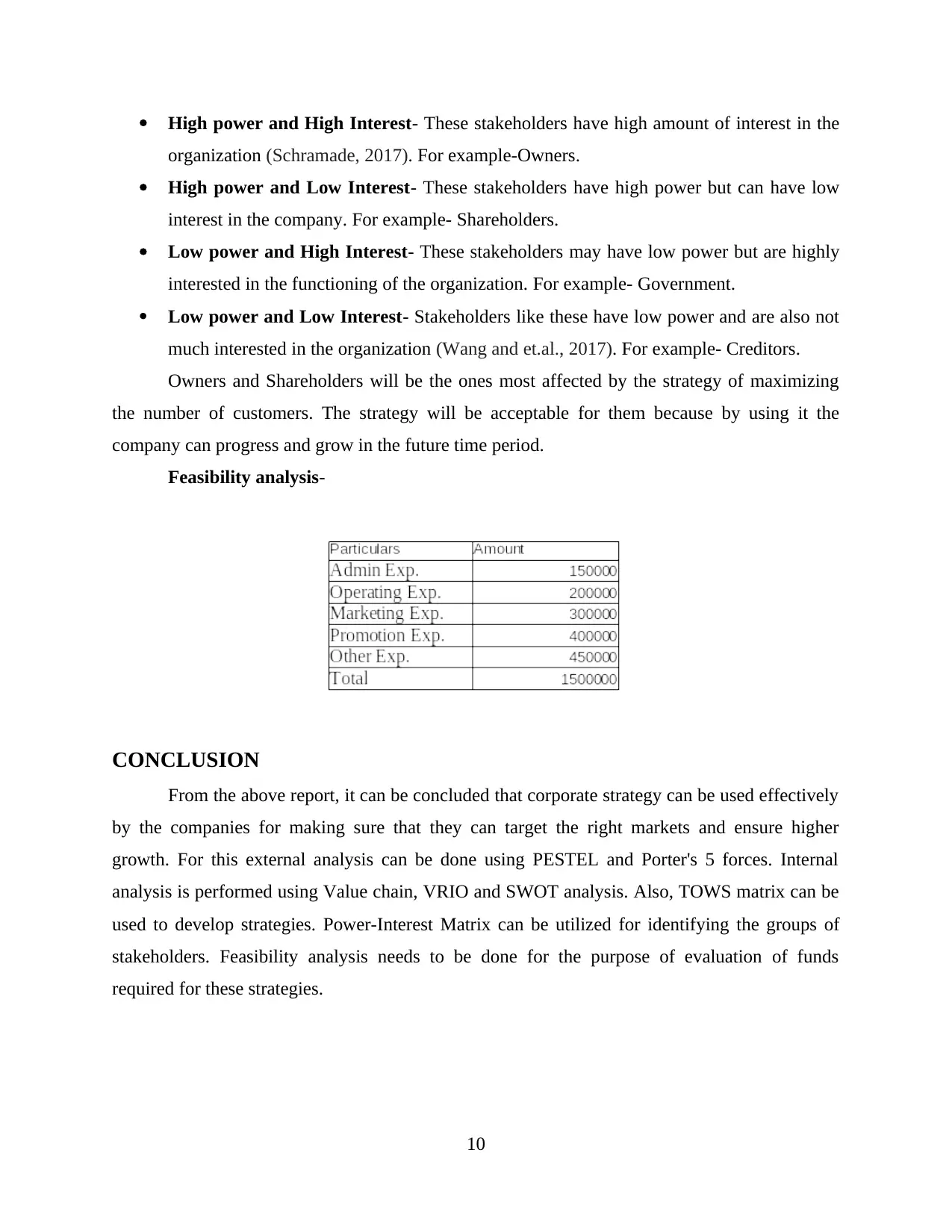
High power and High Interest- These stakeholders have high amount of interest in the
organization (Schramade, 2017). For example-Owners.
High power and Low Interest- These stakeholders have high power but can have low
interest in the company. For example- Shareholders.
Low power and High Interest- These stakeholders may have low power but are highly
interested in the functioning of the organization. For example- Government.
Low power and Low Interest- Stakeholders like these have low power and are also not
much interested in the organization (Wang and et.al., 2017). For example- Creditors.
Owners and Shareholders will be the ones most affected by the strategy of maximizing
the number of customers. The strategy will be acceptable for them because by using it the
company can progress and grow in the future time period.
Feasibility analysis-
CONCLUSION
From the above report, it can be concluded that corporate strategy can be used effectively
by the companies for making sure that they can target the right markets and ensure higher
growth. For this external analysis can be done using PESTEL and Porter's 5 forces. Internal
analysis is performed using Value chain, VRIO and SWOT analysis. Also, TOWS matrix can be
used to develop strategies. Power-Interest Matrix can be utilized for identifying the groups of
stakeholders. Feasibility analysis needs to be done for the purpose of evaluation of funds
required for these strategies.
10
organization (Schramade, 2017). For example-Owners.
High power and Low Interest- These stakeholders have high power but can have low
interest in the company. For example- Shareholders.
Low power and High Interest- These stakeholders may have low power but are highly
interested in the functioning of the organization. For example- Government.
Low power and Low Interest- Stakeholders like these have low power and are also not
much interested in the organization (Wang and et.al., 2017). For example- Creditors.
Owners and Shareholders will be the ones most affected by the strategy of maximizing
the number of customers. The strategy will be acceptable for them because by using it the
company can progress and grow in the future time period.
Feasibility analysis-
CONCLUSION
From the above report, it can be concluded that corporate strategy can be used effectively
by the companies for making sure that they can target the right markets and ensure higher
growth. For this external analysis can be done using PESTEL and Porter's 5 forces. Internal
analysis is performed using Value chain, VRIO and SWOT analysis. Also, TOWS matrix can be
used to develop strategies. Power-Interest Matrix can be utilized for identifying the groups of
stakeholders. Feasibility analysis needs to be done for the purpose of evaluation of funds
required for these strategies.
10
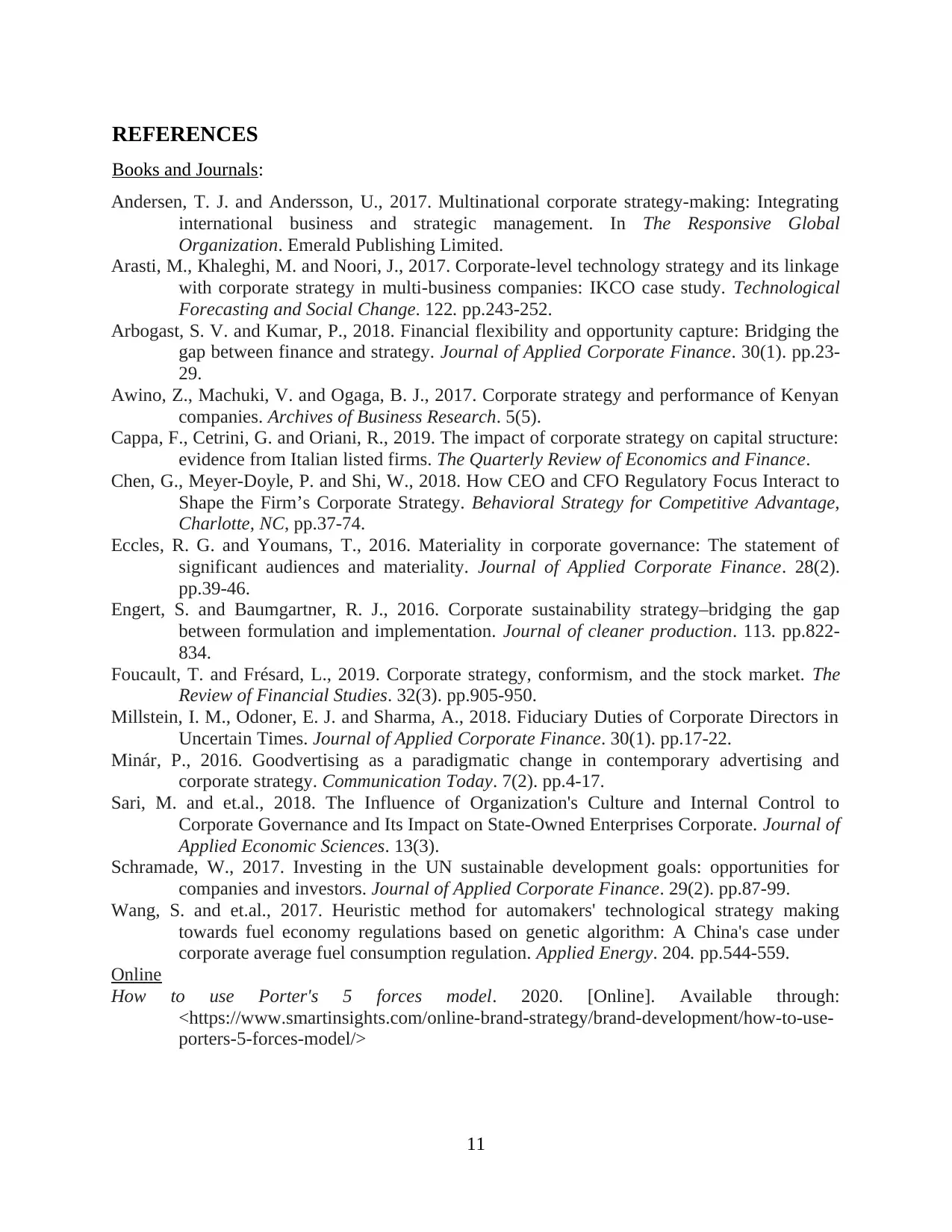
REFERENCES
Books and Journals:
Andersen, T. J. and Andersson, U., 2017. Multinational corporate strategy-making: Integrating
international business and strategic management. In The Responsive Global
Organization. Emerald Publishing Limited.
Arasti, M., Khaleghi, M. and Noori, J., 2017. Corporate-level technology strategy and its linkage
with corporate strategy in multi-business companies: IKCO case study. Technological
Forecasting and Social Change. 122. pp.243-252.
Arbogast, S. V. and Kumar, P., 2018. Financial flexibility and opportunity capture: Bridging the
gap between finance and strategy. Journal of Applied Corporate Finance. 30(1). pp.23-
29.
Awino, Z., Machuki, V. and Ogaga, B. J., 2017. Corporate strategy and performance of Kenyan
companies. Archives of Business Research. 5(5).
Cappa, F., Cetrini, G. and Oriani, R., 2019. The impact of corporate strategy on capital structure:
evidence from Italian listed firms. The Quarterly Review of Economics and Finance.
Chen, G., Meyer-Doyle, P. and Shi, W., 2018. How CEO and CFO Regulatory Focus Interact to
Shape the Firm’s Corporate Strategy. Behavioral Strategy for Competitive Advantage,
Charlotte, NC, pp.37-74.
Eccles, R. G. and Youmans, T., 2016. Materiality in corporate governance: The statement of
significant audiences and materiality. Journal of Applied Corporate Finance. 28(2).
pp.39-46.
Engert, S. and Baumgartner, R. J., 2016. Corporate sustainability strategy–bridging the gap
between formulation and implementation. Journal of cleaner production. 113. pp.822-
834.
Foucault, T. and Frésard, L., 2019. Corporate strategy, conformism, and the stock market. The
Review of Financial Studies. 32(3). pp.905-950.
Millstein, I. M., Odoner, E. J. and Sharma, A., 2018. Fiduciary Duties of Corporate Directors in
Uncertain Times. Journal of Applied Corporate Finance. 30(1). pp.17-22.
Minár, P., 2016. Goodvertising as a paradigmatic change in contemporary advertising and
corporate strategy. Communication Today. 7(2). pp.4-17.
Sari, M. and et.al., 2018. The Influence of Organization's Culture and Internal Control to
Corporate Governance and Its Impact on State-Owned Enterprises Corporate. Journal of
Applied Economic Sciences. 13(3).
Schramade, W., 2017. Investing in the UN sustainable development goals: opportunities for
companies and investors. Journal of Applied Corporate Finance. 29(2). pp.87-99.
Wang, S. and et.al., 2017. Heuristic method for automakers' technological strategy making
towards fuel economy regulations based on genetic algorithm: A China's case under
corporate average fuel consumption regulation. Applied Energy. 204. pp.544-559.
Online
How to use Porter's 5 forces model. 2020. [Online]. Available through:
<https://www.smartinsights.com/online-brand-strategy/brand-development/how-to-use-
porters-5-forces-model/>
11
Books and Journals:
Andersen, T. J. and Andersson, U., 2017. Multinational corporate strategy-making: Integrating
international business and strategic management. In The Responsive Global
Organization. Emerald Publishing Limited.
Arasti, M., Khaleghi, M. and Noori, J., 2017. Corporate-level technology strategy and its linkage
with corporate strategy in multi-business companies: IKCO case study. Technological
Forecasting and Social Change. 122. pp.243-252.
Arbogast, S. V. and Kumar, P., 2018. Financial flexibility and opportunity capture: Bridging the
gap between finance and strategy. Journal of Applied Corporate Finance. 30(1). pp.23-
29.
Awino, Z., Machuki, V. and Ogaga, B. J., 2017. Corporate strategy and performance of Kenyan
companies. Archives of Business Research. 5(5).
Cappa, F., Cetrini, G. and Oriani, R., 2019. The impact of corporate strategy on capital structure:
evidence from Italian listed firms. The Quarterly Review of Economics and Finance.
Chen, G., Meyer-Doyle, P. and Shi, W., 2018. How CEO and CFO Regulatory Focus Interact to
Shape the Firm’s Corporate Strategy. Behavioral Strategy for Competitive Advantage,
Charlotte, NC, pp.37-74.
Eccles, R. G. and Youmans, T., 2016. Materiality in corporate governance: The statement of
significant audiences and materiality. Journal of Applied Corporate Finance. 28(2).
pp.39-46.
Engert, S. and Baumgartner, R. J., 2016. Corporate sustainability strategy–bridging the gap
between formulation and implementation. Journal of cleaner production. 113. pp.822-
834.
Foucault, T. and Frésard, L., 2019. Corporate strategy, conformism, and the stock market. The
Review of Financial Studies. 32(3). pp.905-950.
Millstein, I. M., Odoner, E. J. and Sharma, A., 2018. Fiduciary Duties of Corporate Directors in
Uncertain Times. Journal of Applied Corporate Finance. 30(1). pp.17-22.
Minár, P., 2016. Goodvertising as a paradigmatic change in contemporary advertising and
corporate strategy. Communication Today. 7(2). pp.4-17.
Sari, M. and et.al., 2018. The Influence of Organization's Culture and Internal Control to
Corporate Governance and Its Impact on State-Owned Enterprises Corporate. Journal of
Applied Economic Sciences. 13(3).
Schramade, W., 2017. Investing in the UN sustainable development goals: opportunities for
companies and investors. Journal of Applied Corporate Finance. 29(2). pp.87-99.
Wang, S. and et.al., 2017. Heuristic method for automakers' technological strategy making
towards fuel economy regulations based on genetic algorithm: A China's case under
corporate average fuel consumption regulation. Applied Energy. 204. pp.544-559.
Online
How to use Porter's 5 forces model. 2020. [Online]. Available through:
<https://www.smartinsights.com/online-brand-strategy/brand-development/how-to-use-
porters-5-forces-model/>
11
Paraphrase This Document
Need a fresh take? Get an instant paraphrase of this document with our AI Paraphraser
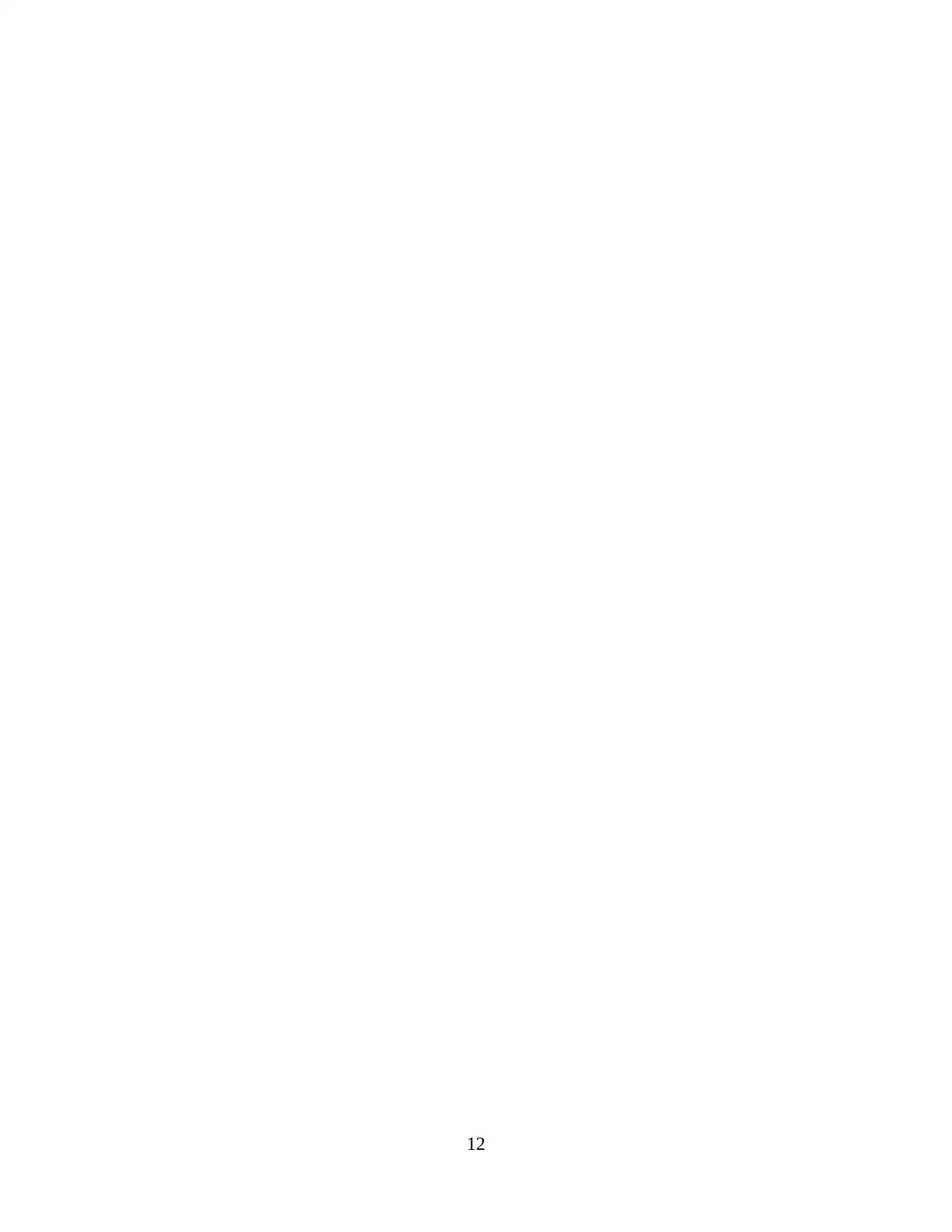
12
1 out of 14
Related Documents
Your All-in-One AI-Powered Toolkit for Academic Success.
+13062052269
info@desklib.com
Available 24*7 on WhatsApp / Email
![[object Object]](/_next/static/media/star-bottom.7253800d.svg)
Unlock your academic potential
© 2024 | Zucol Services PVT LTD | All rights reserved.





